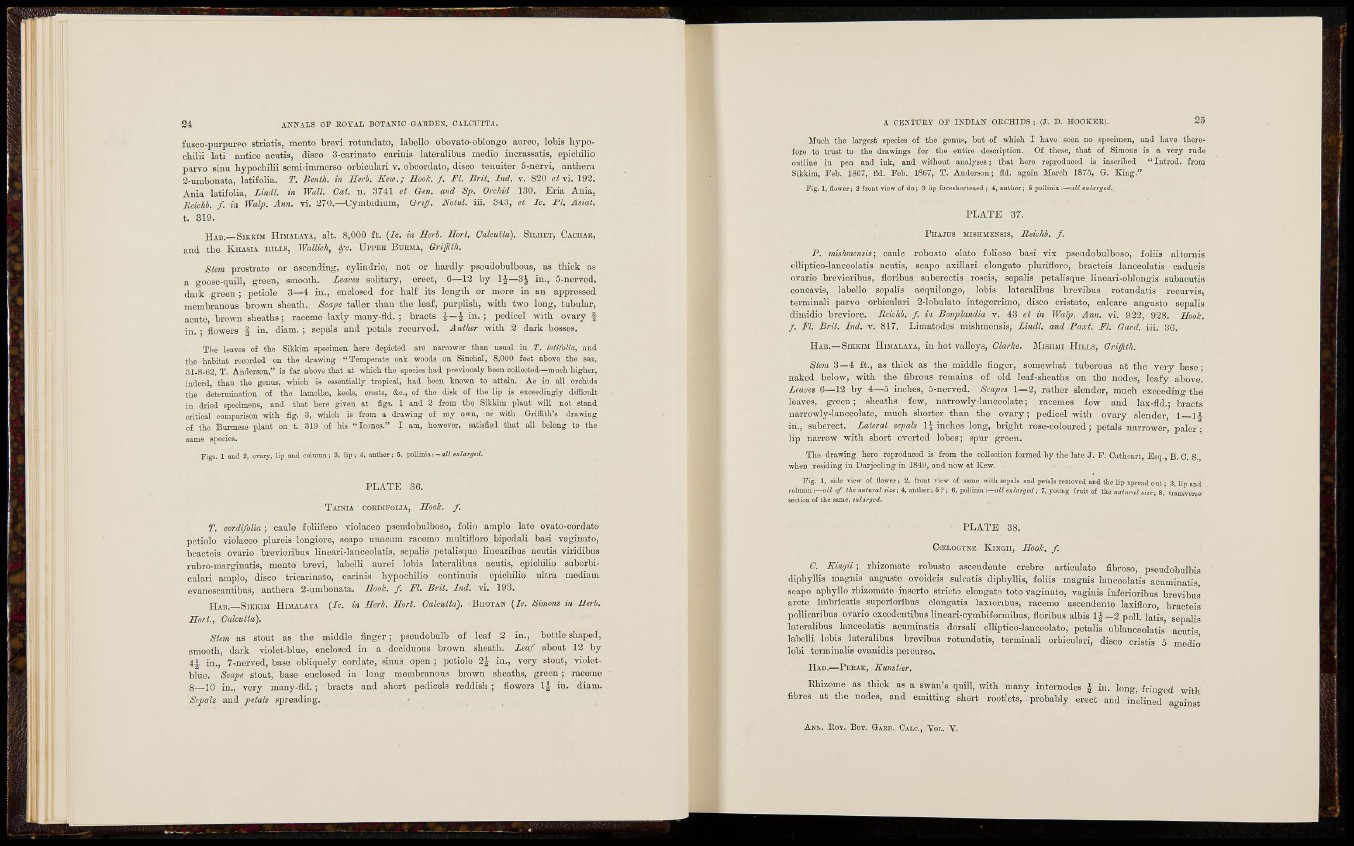
2 4 ANNALS OP HOYAL BOTANIC GARDEN, CALCUTTA.
fusco-purpui'po striatis, meoto "brevi rotundato, labello oboyato-oblongo aureo, lobis hypochilii
lati autice acutis, disco 3-carinato caiinis latei-alibus medio incrassatis, epicMlio
parvo sina liypocHlii somi-immerso orbicukii v. obcordato, disco tenuiter 5-nervi, anthera
2-iimbonata, latifolia. T. Benth. in Herb. Kew.; Hook. / . Fl Brit. Ind. v. 820 eiyi. 192.
Ania latifolia, Lindl. in Wall. Cat. u. 37il et Gen. and Sp. Orchid 130. Eria Ania,
JReichb. f . in Walp. Ann. vi. 270.—Cymbidium, Griff. Notul. in. 343, et Ic. PI. Asiat.
t . 319.
Hab.—SiKKiM Himalaya, alt. 8,000 ft. (ic. in Serb. Hort. CalcuUa). Silhet, Cachar,
and tlio ICnASiA hills, Wallich, fyc. Upper Bukma, Grijjiih,
Stem prostrate or asceudiug, cylindric, not or hardly pseudobulboiTS, as thick as
a goosc-qiiill, green, smooth. Leaves solitary, erect, 6—12 by I j—i n . , S-nerred,
daik green ; petiole 3—4 iQ., enclosed for half its length or more in an appressed
membranous brown sheath. Scape taller than the leaf, purplish, -with two long, tubular,
acute, brown sheaths; raceme laxly mauy-fld. ; bracts ¿ in. ; pedicel with ovary |
in. ; flowers | in. diam. ; sepals and petals recurved. Anther with 2 dark bosses.
Tbe leaves of the Sikkim specimen here depicted are narrower than usual in T. latifolia, and
the habitat recorded on the drawing "Temperate oak wooda on Sinchal, 8,000 feet above the sea,
31-8-62, T. Anderson," is far above that at which the speci« had previously been collected—much higher,
indeed, than the genus, which is essentially tropical, had been known to attain. As in all orchids
the determination of the lameli», keels, crests, &c., of the disk of the lip is exceedingly difficult
in dried specimens, and that here given at figs. 1 and 2 from the Sikkim plant will not stand
critical comparison with fig. 3, which is from a drawing of my own, or with GrifStb's drawing
of the Burmese plant on t. 319 of his "leones." I am, however, satisfied that all belong to the
rigs. 1 and 2, ovary, lip and column; 3, lip; 4, anther; 5, polUniai-oii enZarjferf.
P L A T E 3(5.
Tai>'ia cokdifolia. Hook. f.
T. eordifolia ; caule foliifero violaceo pseudobulboso, folio ampio late ovato-cordato
petiolo violaceo plureis longiore, scapo unacum racemo multifloro bipedali basi vaginato,
bracteis ovario brevioiibus lineari-lanceolatis, sepalis petalisque linearibus acutis viridibus
rubro-marginatis, mento brevi, labelli aurei lobis lateralibus acutis, epichilio suborbiculari
ampio, disco tricariaato, carinis hypochilio continuis epichilio ultra mediam
evanescantibusj anthera 2-umboData. Moolc. f . Fl. Brit. Ind. vi. 193.
Hab.—SiKKiM Himalaya {IC. in Herb. Hort. Calcutta). Buotan {IC. Simons in Herb.
Hort., Calcutta).
Stem as stout as the middle finger; pseudobulb of leaf 2 in., bottle.shaped,
smooth, dark violet-blue, enclosed in a deciduous brown sheath. Lea/ about 12 by
4 i in., 7-nerved, base obliquely cordate, sinus open ; petiole 2 | in., very stout, violetblue.
Scape stout, base enclosed in long membranous brown sheaths, green ; racemo
8—10 in., very many-fld. ; bracts and short pedicels reddish; flowers Ij in. diam.
Sepals and petals spi
A CENTURY OF INDIAN OKCHIDS ; (J. D. HOOKER). 25
Much the largest species of the genus, but of which I have seen no specimen, and have therefore
to trust to the drawings for the entire desciiption. Of those, that of Simons is a very rude
outline iu pen and ink, and without analyses; that here reproduced is inscribed "Introd. from
Sikkim, Feb. 18G7, fid. Feb. 1867, T. Anderson; fid. again March 1870, G. King."
Fig. 1, flower; 2 front Tiew of do; 3 tip foresliorteacd ; 4, anther; 5 poilin -all snlargei.
P L A T E 37.
PUAJUS MISHMENSIS, Rcichh. f.
P. mishmcnsis; caule robusto elato fahoso basi vix psoadobulboao, follia alternis
elliptico-lanceolatis acutis, scapo axillari elongate plurifloro, bracteis lanceolatis caducis
ovario brevioribus, floribus suberectis rosois, sepalis petalisque lineari-obiongis subacuti»
concavis, labello sepalis aoquilongo, lobis lateralibus brevibus rotundatio recurvis,
terminali parvo orbiculaii 2-lobulato integerrimo, disco cristato, calcare angusto sepalis
dimidio breviore. Beivhb. f . in Bonplandia v. 43 et in Walp. Ann. vi. 922, 928. Eook.
f . Fl. Brit. Ind. v. 817. Limatodcs mishmensis, Lindl. and Paxt. FL Gard. iii. 3G.
Hab.—SiKKiM Hdialaya, in hot valleys, Clarke. Misaui Hills, Griffith.
Stem 3—4 ft., as thick as the middle finger, somewhat tuberous at the veiy base;
naked below, with the fibrous remains of old leaf-sheaths on the nodes, leafy above.
Leaoeg 6—12 by 4—5 inches, 5-ncrved. Scapes 1—3, rather slender, much exceeding the
leaves, greca; sheaths few, nan-owly-lanccolate; racemes few and lax-fid.- bracts
narrowly-lanceolate, much shorter than the ovary; pedicel with ovary slender, 1 li
in., suberect. Lateral sepals inches long, bright rose-coloured ; petals narrower, paler ;
lip nan-ow with short evei-ted lobes; spur green.
The drawing here reproduced is from the collection formed by the late J. P. Cathcart, Esq., B. C. S.,
when residing iu Darjeeling in 1849, and now at Kew.
Fig. 1, side view oE flower ; 2, front -view of same wilt sepsis and petals removed and iLe lip spread out ; 3, lip and
column -.—aU of the nalural she; 4, anther; 6 ? ; 6, pollinia -.—aU enlarged-, 7, young fruit of tho natural the; 8, transverse
P L A T E 38.
CCELOGYNE KlNGII, Hook. f .
C. Kingii ; rhizomate robusto ascendente crebre articulato fibroso, pseudobulbis
diphylHs magnis anguste ovoideis sulcatis diphyllis, foliis magnis lanceolatis acuminatis,
scapo aphyllo rhizomate inserto stricto elongato toto vaginato, vaginis inferioiibns brevibus
arete imbricatis superioribus elongatis laxioribus, racemo ascendente lasifloro, bracteis
pollicaribus ovario excedentibus Hneai-i-cymbiforraibus, floribus albis 1^—2 poll. latís, sepalis
lateralibus lanceolatis acuminatis dorsaK elliptico-lancoolato, petalis oblanceolatis acutis
labelli lobis lateralibus brevibus rotundatis, terminali orbicubrí, disco cristis 5 medio
lobi terminalis evanidis percm-so.
Had.—Perak, EurnHer.
Rhizome as thick as a swan's quill, with many intemodes \ in. long, fringed with
fibres at the nodes, and emitting short rootlets, probably erect and inclined against
Ann, Roy. Bor. Gaud. Calc., You Y.